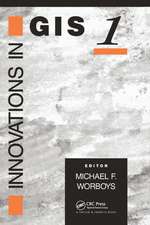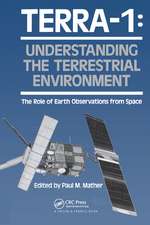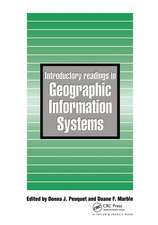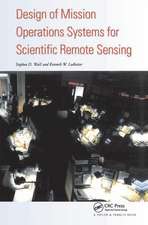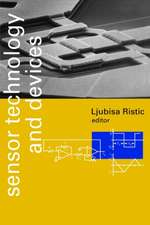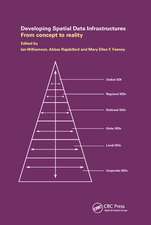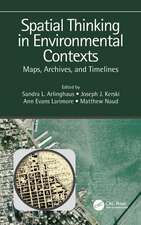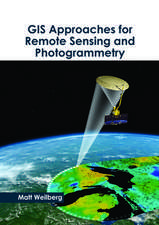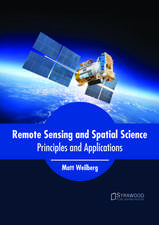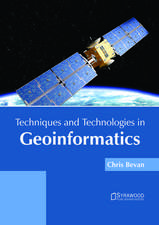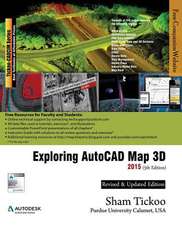Biophysical and Biochemical Characterization and Plant Species Studies: Hyperspectral Remote Sensing of Vegetation, Second Edition
Editat de Prasad S. Thenkabail, John G. Lyon, Alfredo Hueteen Limba Engleză Paperback – 9 ian 2023
Hyperspectral remote sensing or imaging spectroscopy data has been increasingly used in studying and assessing the biophysical and biochemical properties of agricultural crops and natural vegetation. Volume III, Biophysical and Biochemical Characterization and Plant Species Studies demonstrates the methods that are developed and used to study terrestrial vegetation using hyperspectral data. This volume includes extensive discussions on hyperspectral data processing and how to implement data processing mechanisms for specific biophysical and biochemical applications such as crop yield modeling, crop biophysical and biochemical property characterization, and crop moisture assessments. The concluding chapter provides readers with useful guidance on the highlights and essence of Volume III through the editors’ perspective.
Key Features of Volume III:
- Covers recent abilities to better quantify, model, and map plant biophysical, biochemical water, and structural properties.
- Demonstrates characteristic hyperspectral properties through plant diagnostics or throughput phenotyping of plant biophysical, biochemical, water, and structural properties.
- Establishes plant traits through hyperspectral imaging spectroscopy data as well as its integration with other data, such as LiDAR, using data from various platforms (ground-based, UAVs, and earth-observing satellites).
- Studies photosynthetic efficiency and plant health and stress through hyperspectral narrowband vegetation indices.
- Uses hyperspectral data to discriminate plant species and\or their types as well as their characteristics, such as growth stages.
- Compares studies of plant species of agriculture, forests, and other land use\land cover as established by hyperspectral narrowband data versus multispectral broadband data.
- Discusses complete solutions from methods to applications, inventory, and modeling considering various platform (e.g., earth-observing satellites, UAVs, handheld spectroradiometers) from where the data is gathered.
- Dwells on specific applications to detect and map invasive species by using hyperspectral data.
| Toate formatele și edițiile | Preț | Express |
|---|---|---|
| Paperback (1) | 305.94 lei 6-8 săpt. | |
| CRC Press – 9 ian 2023 | 305.94 lei 6-8 săpt. | |
| Hardback (1) | 1076.81 lei 6-8 săpt. | |
| CRC Press – 11 dec 2018 | 1076.81 lei 6-8 săpt. |
Preț: 305.94 lei
Preț vechi: 344.80 lei
-11% Nou
Puncte Express: 459
Preț estimativ în valută:
58.55€ • 63.58$ • 49.18£
58.55€ • 63.58$ • 49.18£
Carte tipărită la comandă
Livrare economică 23 aprilie-07 mai
Preluare comenzi: 021 569.72.76
Specificații
ISBN-13: 9781032475868
ISBN-10: 1032475862
Pagini: 384
Ilustrații: 195
Dimensiuni: 178 x 254 mm
Greutate: 0.76 kg
Ediția:2
Editura: CRC Press
Colecția CRC Press
Seria Hyperspectral Remote Sensing of Vegetation, Second Edition
ISBN-10: 1032475862
Pagini: 384
Ilustrații: 195
Dimensiuni: 178 x 254 mm
Greutate: 0.76 kg
Ediția:2
Editura: CRC Press
Colecția CRC Press
Seria Hyperspectral Remote Sensing of Vegetation, Second Edition
Cuprins
Section I: Vegetation Biophysical and Biochemical Properties 1. Recent Developments in Remote Estimation of Crop Biophysical and Biochemical Properties at Various Scales 2. Hyperspectral Assessment of Ecophysiological Functioning for Diagnostics of Crops and Vegetation 3. Spectral and Spatial Methods for Hyperspectral and Thermal Image-Analysis to Estimate Biophysical and Biochemical Properties of Agricultural Crops 4. Spectral and 3D Nonspectral Approaches to Crop Trait Estimation Using Ground and UAV Sensing 5. Photosynthetic Efficiency and Vegetation Stress Section II: Plant Species Identification and Discrimination 6. Crop Type Discrimination Using Hyperspectral Data: Advances and Perspectives 7. Identification of Canopy Species in Tropical Forests Using Hyperspectral Data 8. Characteristics of Tropical Tree Species in Hyperspectral and Multispectral Data 9. Detecting and Mapping Invasive Plant Species Using Hyperspectral Data 10. Visible, Near Infrared, and Thermal Spectral Radiance On-Board UAVs for High-Throughput Phenotyping of Plant Breeding Trials Section III: Conclusions 11. Fifty Years of Advances in Hyperspectral Remote Sensing of Agriculture and Vegetation—Summary, Insights, and Highlights of Volume III: Biophysical and Biochemical Characterization and Plant Species Studies
Recenzii
"Very comprehensive and an excellent reference, both for practitioners in the field as well as students hoping to learn more about the uses of Hyperspectral Data for characterizing a diverse set of vegetation...There are books by other authors on Hyperspectral approaches and vegetation characterization(non-hyperspectral), but I believe this book stands alone as the final word on Hyperspectral characterization of vegetation. In fact, all the premier works in literature on Hyperspectral characterization of vegetation have been authored by Thenkabail et al.!"
--Dr. Thomas George, CEO, SaraniaSat Inc.
"The publication of the four-volume set, Hyperspectral Remote Sensing of Vegetation, Second Edition, is a landmark effort in providing an important, valuable, and timely contribution that summarizes the state of spectroscopy-based understanding of the Earth’s terrestrial and near shore environments."
--Susan L. Ustin, John Muir Institute
"The second edition of the book is major revision effort and covers all the aspects most descriptively and explicitly for the students, academia and professionals across the discipline. The book provides breadth of innovative applications of mathematical techniques to extract information from the hyperspectral image data. The chapters are contributed by internationally renowned authors in their respective fields...The hand book Hyperspectral Remote Sensing of Vegetation by Prasad S. Thenkabail, John G. Lyon and Alfredo Huete is most comprehensive, designed for learning and the best book in the discipline today."
--Dr. P.S. Roy, ICRISAT-CGIAR
"This book is an absolute gem. The history, the contemporary and the future of hyperspectral remote sensing of vegetation is contained within these pages. New topics on data mining and machine learning are hugely helpful to understand how scientists can go about processing these massive data sets. With great societal challenges such as food security, sustainability, deforestation and land use change, the research presented in this book provides clear evidence that hyperspectral remote sensing has an important and valuable role to play.
The book is a great resource for undergraduate, postgraduate students, research and academics. There is something in this book for everyone. I want it on my shelf."
--Prof. Kevin Tansey, Leicester Institute for Space & Earth Observation
--Dr. Thomas George, CEO, SaraniaSat Inc.
"The publication of the four-volume set, Hyperspectral Remote Sensing of Vegetation, Second Edition, is a landmark effort in providing an important, valuable, and timely contribution that summarizes the state of spectroscopy-based understanding of the Earth’s terrestrial and near shore environments."
--Susan L. Ustin, John Muir Institute
"The second edition of the book is major revision effort and covers all the aspects most descriptively and explicitly for the students, academia and professionals across the discipline. The book provides breadth of innovative applications of mathematical techniques to extract information from the hyperspectral image data. The chapters are contributed by internationally renowned authors in their respective fields...The hand book Hyperspectral Remote Sensing of Vegetation by Prasad S. Thenkabail, John G. Lyon and Alfredo Huete is most comprehensive, designed for learning and the best book in the discipline today."
--Dr. P.S. Roy, ICRISAT-CGIAR
"This book is an absolute gem. The history, the contemporary and the future of hyperspectral remote sensing of vegetation is contained within these pages. New topics on data mining and machine learning are hugely helpful to understand how scientists can go about processing these massive data sets. With great societal challenges such as food security, sustainability, deforestation and land use change, the research presented in this book provides clear evidence that hyperspectral remote sensing has an important and valuable role to play.
The book is a great resource for undergraduate, postgraduate students, research and academics. There is something in this book for everyone. I want it on my shelf."
--Prof. Kevin Tansey, Leicester Institute for Space & Earth Observation
Notă biografică
Dr. Prasad S. Thenkabail, Research Geographer-15, U.S. Geological Survey (USGS), is a world-recognized expert in remote sensing science with multiple major contributions in the field sustained over more than 30 years. He obtained his PhD from the Ohio State University in 1992 and has over 140+ peer-reviewed scientific publications. Dr. Thenkabail has conducted pioneering cutting-edge research in the area of hyperspectral remote sensing of vegetation (https://www.usgs.gov/wgsc/GHISA/) and in that of global croplands and their water use for food security (www.croplands.org). Dr. Thenkabail’s contributions to series of leading edited books on remote sensing science along with his research and other contributions in the subject places his as a noted global expert in remote sensing science. He edited three-volume book entitled Remote Sensing Handbook published by Taylor and Francis, with 82 chapters and more than 2000 pages, widely considered a "magnus opus" encyclopedic standard reference for students, scholars, practitioners, and major experts in remote sensing science. He has recently completed editing four-volume Hyperspectral Remote Sensing of Vegetation. He has also edited a book on Remote Sensing of Global Croplands for Food Security. He is currently an editor-in-chief of the Remote Sensing open access journal published by MDPI; an associate editor of the journal Photogrammetric Engineering and Remote Sensing (PERS) of the American Society of Photogrammetry and Remote Sensing (ASPRS); and an editorial advisory board member of the International Society of Photogrammetry and Remote Sensing (ISPRS) Journal of Photogrammetry and Remote Sensing. NASA and USGS selected him on the Landsat Science team (2007-2011). Earlier, he served on the editorial board of Remote Sensing of Environment for many years (2007–2017). He has won three best paper awards from ASPRS for his publications in PE&RS. Detailed bio of Dr. Thenkabail can be found here: https://www.usgs.gov/staff-profiles/prasad-thenkabail
John G. Lyon has conducted scientific and engineering research and administrative functions throughout his career. He is formerly the senior physical scientist in the U.S. Environmental Protection Agency’s Office of Research and Development (ORD) and Office of the Science Advisor in Washington, DC, where he co-led work on the Group on Earth Observations and the USGEO subcommittee of the Committee on Environment and Natural Resources, and research on geospatial issues. Lyon was director of ORD’s Environmental Sciences Division for approximately eight years. He was educated at Reed College in Portland, Oregon, and the University of Michigan in Ann Arbor.
Professor Alfredo Huete leads the Ecosystem Dynamics Health and Resilience research program within the Climate Change Cluster (C3) at the University of Technology Sydney, Australia. His main research interest is in using remote sensing to study and analyze broad scale vegetation health and functioning. Recently, he used remote sensing and field measurements to understand the phenology patterns of tropical rainforests and savannas in the Amazon and Southeast Asia and his Amazon work was featured in a National Geographic television special entitled "The Big Picture". Currently his research involves coupling eddy covariance tower flux measurements with ground spectral sensors and satellite observations to study carbon and water cycling across Australian landscapes. He is actively involved with several international space programs, including the NASA-EOS MODIS Science Team, the Japanese JAXA GCOM-SGLI Science Team, the European PROBA-V User Expert Group, and NPOESS-VIIRS advisory group.
John G. Lyon has conducted scientific and engineering research and administrative functions throughout his career. He is formerly the senior physical scientist in the U.S. Environmental Protection Agency’s Office of Research and Development (ORD) and Office of the Science Advisor in Washington, DC, where he co-led work on the Group on Earth Observations and the USGEO subcommittee of the Committee on Environment and Natural Resources, and research on geospatial issues. Lyon was director of ORD’s Environmental Sciences Division for approximately eight years. He was educated at Reed College in Portland, Oregon, and the University of Michigan in Ann Arbor.
Professor Alfredo Huete leads the Ecosystem Dynamics Health and Resilience research program within the Climate Change Cluster (C3) at the University of Technology Sydney, Australia. His main research interest is in using remote sensing to study and analyze broad scale vegetation health and functioning. Recently, he used remote sensing and field measurements to understand the phenology patterns of tropical rainforests and savannas in the Amazon and Southeast Asia and his Amazon work was featured in a National Geographic television special entitled "The Big Picture". Currently his research involves coupling eddy covariance tower flux measurements with ground spectral sensors and satellite observations to study carbon and water cycling across Australian landscapes. He is actively involved with several international space programs, including the NASA-EOS MODIS Science Team, the Japanese JAXA GCOM-SGLI Science Team, the European PROBA-V User Expert Group, and NPOESS-VIIRS advisory group.
Descriere
This volume reviews existing “state-of-art” knowledge, highlights the advances made, and provides guidance for appropriate use of hyperspectral data in applications such as crop yield modeling, crop biophysical and biochemical property characterization, and crop moisture assessment. Includes extensive discussions on data process





